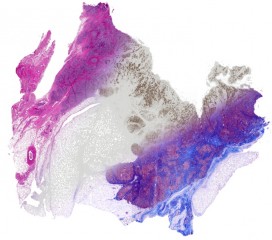Jun 18 2015
An NIBIB-funded researcher has developed a new technique that creates digital pictures of a tissue’s chemical composition using light and a computer. The technique replaces the need for dyes or stains, which can be costly and require significant time and effort to apply.
 Breast tissue showing three different computer-generated stains created using infrared imaging. Credit: Rohit Bhargava, University of Illinois at Urbana-Champaign
Breast tissue showing three different computer-generated stains created using infrared imaging. Credit: Rohit Bhargava, University of Illinois at Urbana-Champaign
Dyes and stains have been used for well over a hundred years in medicine and biomedical research to highlight the architecture of tissues under a microscope. While some dyes and stains highlight broad areas within a cell, such as those with positive or negative charges, others highlight specific entities such as collagen or distinct cell types such as neurons. In the past several decades, even more precise “molecular stains” have been developed that reveal the presence of different proteins within a cell.
Pathologists use dyes and stains to ascertain critical information about tissue samples taken from a biopsy. This information can be used to diagnose disease and to inform prognoses and treatment strategies. Often pathologists need to use multiple stains to fully characterize a tissue sample. For example, certain stains are used to reveal the types of cells present in a tumor biopsy, whether they are normal or abnormal, and their arrangement in context to one other. Other stains may be needed to identify specific molecular characteristics that can further aid diagnosis and help determine whether a tumor might be more or less responsive to a particular treatment.
Biomedical researchers also rely heavily on dyes and stains when conducting research in animals. Animals provide good models for studying human disease and for developing and testing new treatments. As part of the research process, animal tissues are commonly analyzed under a microscope using a wide variety of dyes and stains.
Yet despite its importance in medicine and biomedical research, dyeing and staining tissue is a time-consuming and costly endeavor. One reason is that only a few stains can be used on a tissue section before it becomes damaged or difficult to re-stain.
As a result, multiple tissue sections are usually needed in order to carry out multiple stains. This process of obtaining multiple tissue sections, mounting them onto slides, staining, and imaging them, is onerous and can become costly as more stains and supplies are needed. Additionally, obtaining multiple tissue sections is not always feasible when tissue is limited, such as when tissue is taken from a fine needle biopsy.
Now, with funding support from NIBIB, Rohit Bhargava, Ph.D., Professor of Bioengineering at the University of Illinois at Urbana-Champaign, has developed a technique that eliminates the need for stains or dyes entirely.
The technique uses infrared light to scan a tissue section and measure the unique way that the light is absorbed by different chemical structures present in the tissue, referred to as the structure’s spectral pattern. This spectral information is then run through a computer, which uses pattern recognition algorithms to translate it into chemical “stain” patterns. The end result is a digital image that looks nearly identical to a traditionally stained piece of tissue. Bhargava published the technique in the March 2015 issue of the journal Technology.
Because the technique has no physical effect on the tissue, there’s no limit to the number of different computer-generated “stains” that can be created and superimposed onto each other. “With this technique, you could visualize a large spectrum of different stains on a single tissue section,” said Bhargava. “You could probe an entire tumor microenvironment in one scan, for example.”
Such capabilities could greatly reduce the amount of effort and cost that goes into staining multiple tissue sections and even enable exploratory staining, since preserving tissue would no longer be a limitation. Using a computer to generate “stains” could also help make analyzing tissue a more accurate process by reducing much of the between-sample variability that occurs with chemical staining. Bhargava recently validated the new technique by comparing chemically stained and computationally stained tissue taken from 98 patients.
“This flexible, fast approach to staining is a prime example of the importance of investing in new light sources, such as those that enable infrared spectroscopy, and in developing better image analysis,” said Richard Conroy, Ph.D., Director of the Division of Applied Science & Technology at NIBIB. “These kinds of technologies, which make processes faster, cheaper, and more accurate, can have profound effects on medicine and biomedical research. They enable us to push the envelope, to ask bigger questions than we could before.”
Bhargava says the next steps for the technology are to speed up the process from several hours down to a matter of minutes.
This advance was funded by NIH grants from the National Institute of Biomedical Imaging and Bioengineering (EB009745) and the National Cancer Institute (CA138882) and the National Library of Medicine (LM011390).
Stain-less staining for computed histopathology. Mayerich D, Walsh MJ, Kadjacsy-Balla A, Ray PS, Hewitt SM, Bhargava R. Technology (Singap World Sci). 2015 Mar;3(1):27-31.